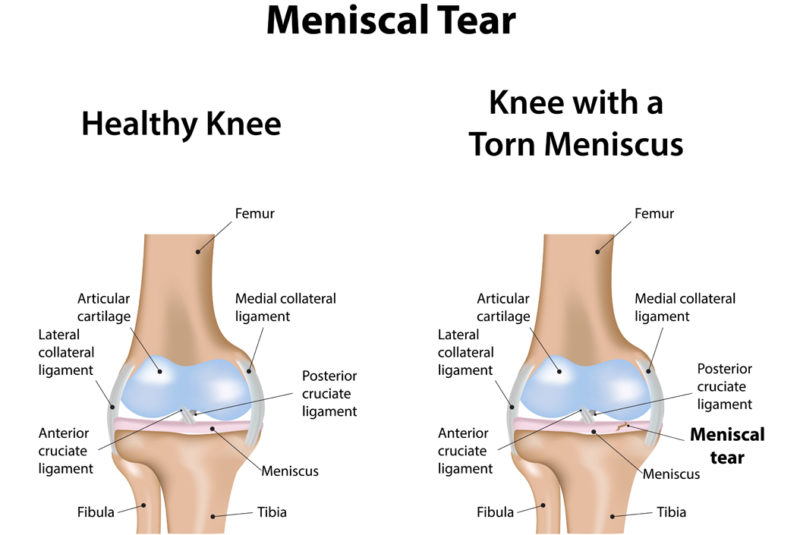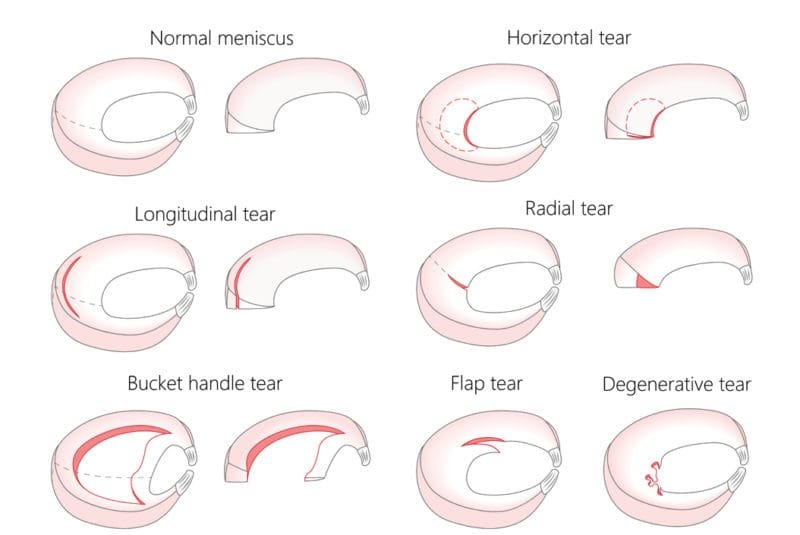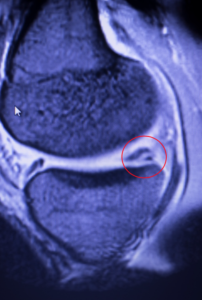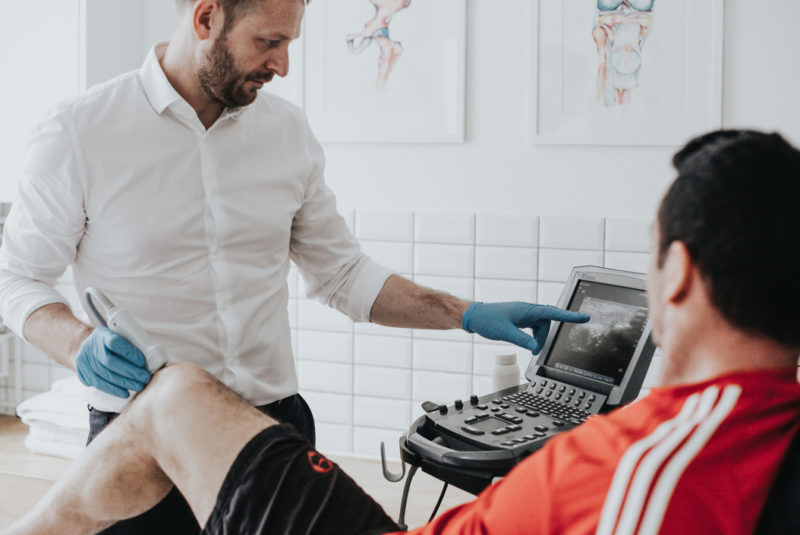What is a meniscal (cartilage) tear?
A meniscal (cartilage) tear is a common knee condition that effects both men and women of all ages. It is common in those participating in impact sports such as running and particularly common in those that involve twisting such as football, tennis and squash. It causes localised pain, swelling and restriction in bending and/or straightening your knee.
If the medial meniscus (located on the inside of the knee joint) is torn, you will experience pain on the inside of your knee. If the lateral meniscus (located on the outside of the knee joint) is torn, you will experience pain on the outside of your knee. Of course, you can have pain both on the inside and outside of your knee if you have torn both menisci. If you experience what is known medically as ‘mechanical’ symptoms, you may require a surgical opinion. ‘Mechanical’ symptoms refer to when the knee joint gets stuck or ‘locked’ in one position and/or you experience a painful ‘catch’ in the joint.
To diagnose a meniscal tear requires a careful clinical examination and an MRI scan. If you have been diagnosed with a meniscal tear, physiotherapy is the first line of treatment and is likely to involve advice regarding activity modification, as well as rehabilitation exercises to restore full range of movement and improve the strength and stability of your knee joint.
If your pain fails to improve with a course of physiotherapy or you are struggling to engage in a course of physiotherapy because the knee is swollen and painful, an ultrasound guided injection can provide rapid pain relief. There are three injection options available; steroid, hyaluronic acid (HA) and platelet rich plasma (PRP) injections. Which injection is most appropriate for you will depend on many factors including your age, functional level, sporting goals, your exact diagnosis, and whether you have osteoarthritis (OA) associated with your meniscal tear.
What are the symptoms of a meniscal (cartilage) tear?
The symptoms of a meniscal (cartilage) tear are:
- Pain located on the inside or outside of the knee joint depending on whether it is a medial meniscus tear (pain on inside of the knee joint) or lateral meniscus tear (pain on outside of the joint)
- Swelling and restriction when bending and straightening the knee
- Mechanical symptoms such as locking and catching.
If this sounds like your pain, read on below…
What other conditions can mimic a meniscal (cartilage) tear?
If this does not sound like your pain there are other conditions that can mimic the pain of a meniscal (cartilage) tear, such as:
- Patellofemoral (knee cap) pain
- Patella tendinopathy (Jumper’s knee)
- Pes anserine bursitis
- Osteoarthritis of the knee
- Iliotibial band (ITB) friction syndrome (runner’s knee)
Meniscal (cartilage) tear vs osteoarthritis (OA) of the knee
A meniscal tear causes pain on the inside of the knee and can cause swelling and is often associated with a restriction in movement. These symptoms are similar if you have osteoarthritis of the knee and in fact these two conditions often exist together particularly if you are over 40 or 50. Osteoarthritis normally has a gradual onset of pain and stiffness, whereas a cartilage tear, particularly in those under the age of 40 is normally caused by a twisting injury.
Osteoarthritis (OA) of the knee is more common in the older population and it causes more diffuse (generalised) pain in the knee. Furthermore, those suffering with knee osteoarthritis are more likely to have more pain and stiffness particularly in the morning and it takes approximately 30 minutes for the knee to ease up. Morning pain and stiffness is less common with meniscal (cartilage) tears.
What is a meniscal tear?
The meniscus is a C-shaped cartilage located between the knee joint and it can tear with sudden unaccustomed twisting movement. It provides stability and cushioning to the joint. We have a medial (inside of the knee) and lateral (outside of the knee) meniscus. Each meniscus has an anterior and posterior horn. The most common meniscal tear occurs in the posterior horn on the medial meniscus.

Meniscal tears often occur due to unaccustomed twisting and rotational movements to the knee that impact on the cartilage e.g. during a tackle in football. This is known as an acute meniscal tear. They can also occur for no reason, especially as we get older and these are often called degenerative meniscal tears.
There are many different types of meniscal tears (see image below). An MRI scan is the only way of knowing what type of tear you have sustained.


MRI showing a tear (red circle) of the medial meniscus
Is an injection effective for a meniscal tear?
Most meniscal tears improve with a period of rest and a course of physiotherapy. Surgery is indicated only if you have certain ‘mechanical’ symptoms. These symptoms may include locking of the knee and a significant reduction in the range of movement. Pain is not an indication for surgery unless accompanied by these ‘mechanical’ symptoms.
Injection therapy is indicated for a specific group of patients where surgery is not appropriate and pain is limiting the range of movement and function. An injection does not heal the tear but does reduce the pain and inflammation in the joint. An injection can give you a pain-free window to work with your physiotherapist to strengthen the knee and restore the normal mechanics of the joint.
Often the pain associated with a meniscal tear is not coming from the tear itself but inflammation of the joint lining. The lining of the joint is called the synovium. When the synovium becomes inflamed it is called ‘joint synovitis’. Diagnostic ultrasound is the best way of diagnosing synovitis.
At Complete, we will always perform a diagnostic ultrasound of your knee before we consider injection therapy. This also helps us target the correct area of the knee with an injection. We do not charge extra for the ultrasound prior to injection.

The ultrasound scan will also assess how much fluid you have in your joint i.e. swelling. Excessive joint fluid is known as a joint effusion. If your knee is very swollen, we will ‘aspirate’ the joint to remove all the excess fluid. This normally has a positive and immediate improvement in your pain and range of movement.
Ultrasound can also visualise meniscal cysts which can occur secondary to a meniscal tear. Meniscal cysts are small fluid-filled pockets that arise from the meniscus. Using ultrasound guidance, the cyst can be drained. This can be a very effective procedure to reduce pain.
When should you consider a steroid injection for a meniscal tear?
Each patient is carefully assessed before any injection is carried out to ensure it is the right treatment for you.
Injection therapy should only be considered if your pain is not improving and you are finding it difficult to carry out normal daily activities such as walking, kneeling, going up and downstairs and/or squatting. We also see many clients who are unable to play sport, be it football, cricket or going for a run due to the pain in their knee.
If your pain is limiting your ability to engage in a physiotherapy programme, an injection can help to settle the pain and provide a window of opportunity for you to progress with your exercises.

It is uncommon to consider injection therapy if you have had the knee pain for less than 6 weeks.
We work closely with many orthopaedic surgeons who will often try one injection for a meniscal tear before considering surgery. This can often reduce your pain and avoid any surgical procedures. There is also a group of patients who have a meniscal tear and osteoarthritis in their knee joint. These patients are unlikely to be offered surgery as the outcome of meniscal surgery with osteoarthritis are poor. This group can benefit from an injection followed by a course of physiotherapy.
Before considering a steroid injection, we would advise you follow these steps:
- Rest from aggravating movements and exercises, for example, avoid or reduce your running
- Try an anti-inflammatory cream. The joint is very superficial so topical medication maybe
helpful onto the painful area (speak to a pharmacist) - Physiotherapy to improve your knee joint range of motion and improve the strength of your
leg musculature particularly the quadriceps muscle (the muscle on the front of your thigh) - Consider wearing a light neoprene brace
- Give the body time to heal. We would advise a minimum of 6 weeks before considering injection therapy.
What injection is effective for meniscal tears?
At Complete Physio, we have a team of highly specialised physiotherapists who carry out ultrasound-guided injections for meniscal injuries. There are two main injection options; steroid or hyaluronic acid injections.
Steroid injection
Steroid is a strong anti-inflammatory and is deposited directly into your knee joint using ultrasound guidance. This ensures the drug is deposited in the correct place. We carry out all of our injection using ultrasound guidance to ensure the accuracy and effectiveness of the injection. A local anaesthetic is also used to reduce any potential pain associated with the procedure.
Hyaluronic Acid injection
Hyaluronic acid is a naturally occurring joint lubricant. It is not classified as a drug and is an effective and safe alternative to a steroid. Hyaluronic acid does have anti-inflammatory properties but is not as strong an anti-inflammatory as steroid. It acts by lubricating and improving the shock-absorbing properties of the joint. The products we use are called Ostenil Plus and Durolane. These have the highest molecular weight of all hyaluronic acid products on the market. They are both one-off injections.

How many injections can you have for a meniscal tear?
A majority of our patients only require one injection to settle their pain and complete their rehabilitation. On occasions, we may have to repeat the injection if the pain returns but this is rare. Hyaluronic acid injections can be repeated on a yearly basis.
If you would like further information or to book an appointment please contact us on 0207 4823875 or email injections@complete-physio.co.uk.
Related conditions, blogs and patient’s stories from our specialists
Our highly experienced team of expert clinicians have written a selection of blogs on various treatment methods for meniscal tears, some stories from patients that came to us seeking relief from their knee pain, as well as explanations of other knee conditions that might be causing your pain. Please take a look at any of the following links and get in touch with us if you think you are suffering from any of these conditions and may require treatment.


Leave A Comment